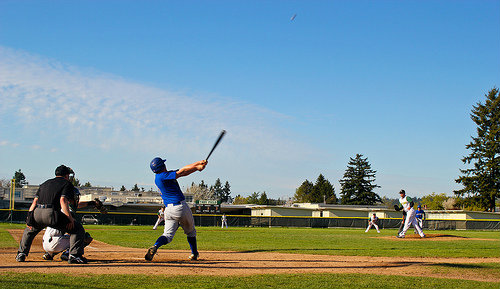Hitting Guidelines - the Swing

Our stride and load are now complete and we will begin the swing. The most important thing to remember at this point is that our front foot must be down before we start our swing. That is the separation of the stride/load and the swing.
Hips initiate the swing
Why: The initial reflex to swing at the pitch is started at the hips and the hands come right behind guiding the bat to the pitch and making all necessary adjustments. If we initiate the swing with the hands, we are going to have a hard time adjusting to an off speed pitch. We also will not be fully utilizing our bottom half, robbing us of power.
***Hands go straight to pitch (projected path) from launching zone (create swing plane)***
Why: This is where the fun begins. When you begin your swing, your eyes have just told your hands where to go and now they are on their way. Of all the things you have learned up to this point, this is the hardest to control. Up until now, you have controlled everything you have done; now your reflexes take over. The essence of the swing is now in full force. In its simplest form, this is the make or break point of the swing.
The most common flaw seen in young hitters is dropping their back shoulder and/or their hands, and then starting their swing. That’s why this is THE most crucial element in the swing. The hands must go straight to the projected path of the pitch from the launching point.
Weight shifts from back foot to against firm front leg
Why: When you swing against a firm front side or stiff front leg, it stops the weight transfer. As you begin your swing, your front heel will drop and your front leg should begin to straighten out. When the weight transfer stops, your body and head should stop, giving you a good perception of the pitch. When the weight stops, it also gives you an axis to rotate around (front leg). The creation of this axis is what allows us to create tremendous torque with our hips, generating lower body power and bat speed.
Contact Position. The hands have started on their path to the pitch and the rear elbow slots down by the hitters’ side and the hands push the bat to the projected contact zone. Contact will be made in a palm up-palm down position with the rear arm still not fully extended.
Why: This is the strongest arm positioning. Try it. Go up to a wall with your bat. Get your rear arm in a position between 90 degrees and full extension and place your bat against the wall. See how much strength you have. Now get your rear arm at full extension and do the same thing. Big difference.
Full extension of arms through the ball
Why: This is where upper body and wrist strength really come in handy and you explode through the ball.
- Wrists roll after extension
- Finish at or near the corner of the front shoulder with your hands
Our swing plane has been created. We start our hands from the launching position, get to contact, extend our arms and finish at the corner of the front shoulder. Picture it like a disc and you are just swinging along this plane. The plane should always be consistent. The only thing that changes is the angle of the plane, the size of the disc and where you make contact along it. The higher the pitch, the flatter the plane, the lower the pitch, the steeper the plane. The closer in the pitch, the smaller the disc, the further out the pitch, the larger the disc. In baseball, it is very difficult to take a perfect swing every time. But in practice and drills, this is what we strive for, perfection, and the creation of muscle memory.
- Hips rotate fully
Why: A full 90-degree rotation of the hips must occur to have maximum impact on the ball. The back foot in line with the pitcher after follow through will evidence this.
Shoulders rotate fully
Why: For the same reason the hips must fully rotate, the upper body must fully rotate as well. The back shoulder pointing at the pitcher at follow through evidences this.
Stay balanced
This is part three of a three part article
Click here to read part one: The Set-up
Click here to read part two: Stride and Load
"Swing" © 2013 Thomas Soerenes, used under a Creative Commons Attribution-ShareAlike license: http://

